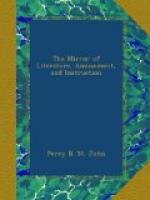The full attendance at the private view on Friday, accorded with these gratifying statements. Suffolk-street and Pall Mall East were crowded with the carriages of visiters, and in the rooms was an abundant sprinkling of nobility, patrons of art, men of letters, and some note of purchases at the keeper’s table. There are upwards of 800 Pictures, and about 100 specimens of Sculpture and Engraving. The crowded state of the rooms during the hour that we were there, allowed us only to note a few works.
1. Cardinal Weld; a well painted portrait, by James Ramsey, of the benevolent owner of Lulworth Castle. The features are dignified and finely intellectual. We could, too, associate their expression with the philanthropic act of the Cardinal’s affording an asylum to fallen royalty.
13. Ruins. D. Roberts. A delightful composition, from these exquisite lines by Mrs. Hemans:
“There have been bright and
glorious pageants here,
Where now grey stones and
moss-grown columns lie—
There have been words, which earth grew
pale to hear,
Breath’d from the cavern’s
misty chambers nigh:
There have been voices through
the sunny sky,
And the pine woods, their choral hymn-notes
sending,
And reeds and lyres, their
Dorian melody,
With incense clouds around the temple
blending,
And throngs, with laurel boughs,
before the altar bending.”
27. A Philosopher. H. Wyatt. Admirably coloured: the flesh tints and deep expression of the features will not escape notice.
52. The Town of Menagio, on the Lake of Como. T.C. Hofland. A scene of beautiful repose in the artist’s best style.
57. Portrait of Mrs. Davenport in the character of the Nurse in “Romeo and Juliet.” James Holmes. Almost speakingly characteristic. You may imagine the actress drawling out, “awear—y,” and her attitude admirably accords with “Fie, how my bones ache.”
114. The Baptism. G. Harvey, S.A. Foremost among the attractions of the Exhibition, though of a serious turn. The quotation will best describe the subject:




